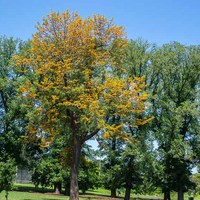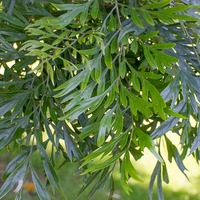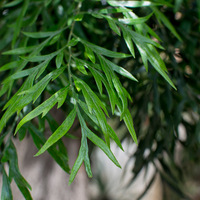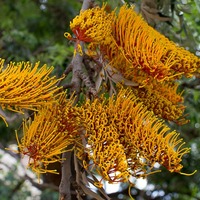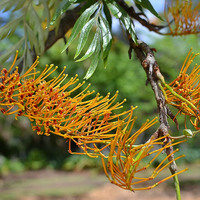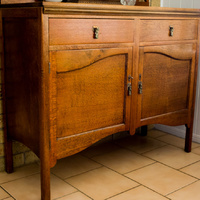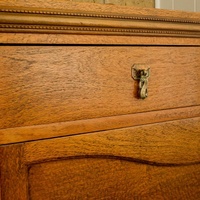Common name: Silky Oak
Other common names: Fernleaf, Golden Pine, Silk Oak, Silver Oak, Southern Silky Oak
Description
Silky Oak is an ornamental, timber, agroforestry and honey tree originating in Australia, where it occurs in subtropical forests along the eastern coast.
It is a fast-growing tree, to heights of up to 35 m (114 ft) in its natural habitat, though elsewhere, it is more typically 15 to 25 m (50 to 80 ft) tall and develops a straight trunk supporting a pyramidal or rounded crown. The bark is grey-brown and fissured.
Leaves are fern-like, dark green on top, silvery beneath and in a dense arrangement that casts a deep shade. They remain on the tree where the dry season is short but fall where it is long or pronounced, leaving the branches almost bare for a short period, just before flowering.
The flowers are thin, erect, orange-yellow tubes in long clusters that somewhat resemble a brush with bristles. They bloom in perfusion from spring to early summer, with the most striking displays on near leafless trees.
Fruit are small, flat, oval seedpods that, when mature, are dark brown to near black with one or two-winged seed inside.
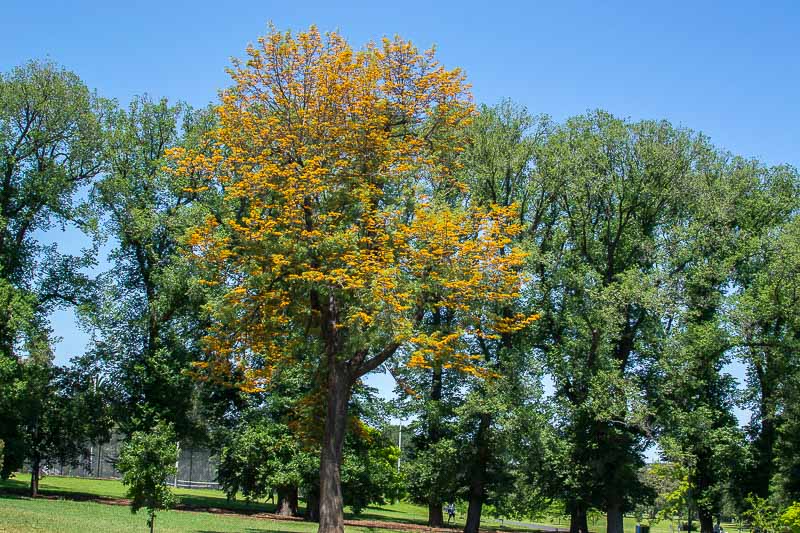
Tree in full bloom (Melbourne, Australia)
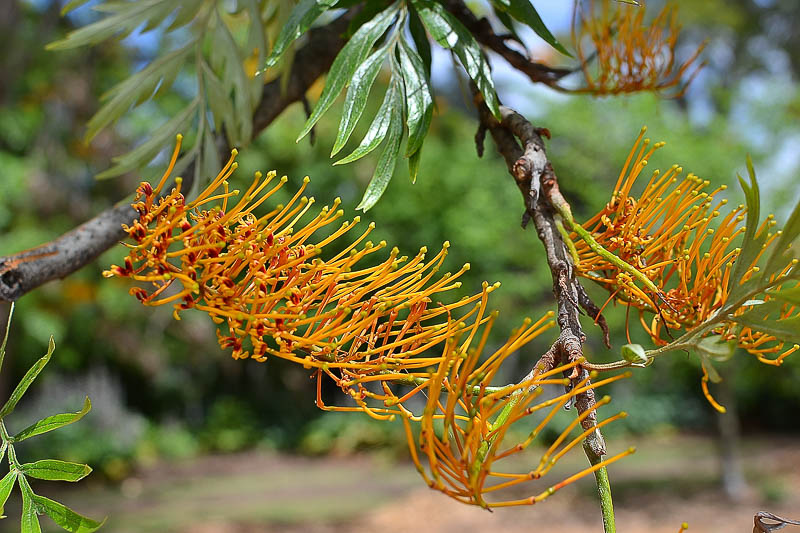
Flower cluster
Use
Ornamental: Silky Oak is cultivated in gardens, urban landscapes, and parks, especially in Australia, for its spectacular flowering, eye-catching foliage, and the shade it provides.
Agroforestry: Introduced decades ago in India, Sri Lanka and Kenya, it is cultivated there as a shade tree to shade crops such as tea (Camellia sinensis) and coffee (Coffea arabica) due to its fast growth and good adaptation to tropical highland climates. It is also grown for fuelwood, including firewood and charcoal, protective windbreaks and honey production.
Honey: The flowers produce reasonable quantities of nectar. It is reported as a honey tree in Australia and in countries where it's introduced, including India, Tanzania, Guatemala and the Dominican Republic. The honey is dark amber with a pronounced flavour, dense texture, and quick to granulate to a smooth grain. The nectar also helps to nourish and sustain nectar-eating birds in its native region, making it an important wildlife tree.
Silky Oak honey (Courtesy: Malfroy's Gold)
Timber: The wood is medium-weight, in the 540 to 660 kgs per cubic meter (34 to 41 lbs per cubic ft) range and has attractively figured pinkish-brown heartwood. It is moderately resistant to rot and decay, making it fit for indoor and some outdoor applications.
Well-formed logs are sawn into planks used mostly for fine furniture, cabinets, interior flooring, interior house trim, doors, window-frames and the like. Selected logs are sliced for decorative veneer and the branch-wood, apart from fuelwood, is used in turnery.
Climate
Silky Oak develops a good form in sub-humid to humid subtropical and tropical mid- to high-elevation climates, generally areas with annual lows of 8 to 20°C, annual highs of 19 to 32°C, annual rainfall of 600 to 2400 mm and a dry season of 6 months or less, extending to 12 months with irrigation or groundwater. In Hawaii, the best-developed trees occur in mid-elevation areas with annual rainfall of 1500 to 2000 mm.
Trees may fail to flower or flower poorly in extreme high-elevation areas, such as Bogotá (Colombia), Addis Ababa (Ethiopia) and Mexico City. Generally, areas where the average low of the warmest month is below 13°C (55°F).
Growing
New plants are usually raised from seed, which remain viable for up to a year under cold, dry, airtight storage and germinate within thirty days of sowing.
Silky Oak trees perform best on free-draining clay-loam, loam and sandy-loam soils of an acid to neutral nature, generally with a pH of 4.5 to 7.5, and on sites with full to partial sun exposure.
Problem features
The winged seed are carried over long distances by wind and germinate readily. It has naturalised in many areas where it is introduced and has become an undesirable weed in some parts. In South Africa, it is recorded as a serious invader of the natural ecosystem and in Hawaii as a high weed risk, as assessed by the Hawaii Pacific Weed Risk Assessment (HPWRA) project.
The branches are brittle and prone to breakage in strong winds, potentially causing personal injury or property damage. The flowers, fruit and sap may cause dermatitis in some people, and the fallen leaves create leaf litter.
Where it grows
References
Books
-
Adams, C. D. 1972, Flowering plants of Jamaica, University of the West Indies, Mona, Greater Kingston
-
Barwick, M., et al. 2004, Tropical & subtropical trees : a worldwide encyclopaedic guide, Thames and Hudson, London
-
Boland, D. & Brooker, I. & McDonald, M. W. 2006, Forest trees of Australia, 5th ed., CSIRO Publishing (Ensis), Melbourne
-
Bradbear, N. 2009, Bees and their role in forest livelihoods : a guide to the services provided by bees and the sustainable harvesting, processing and marketing of their products, Food and Agriculture Organization of the United Nations (FAO), Rome
-
Burke, D. 2005, The complete Burke's backyard : the ultimate book of fact sheets, Murdoch Books, New South Wales, Australia
-
Burns R.M., Mosquera M.S. & Whitmone J.L. 1998, Useful trees of the tropical region of North America, North American Forestry Commission Publication (Number 3), Washington D.C.
-
Burns, R.M. & Honkala, B.H. 1990, Silvics of North America (Volume 2) : Hardwoods, Agricultural Handbook 654, U.S. Department of Agriculture (USDA), Washington D.C.
-
Chudnoff, M. 1984, Tropical timbers of the world, Forest Service, U.S. Department of Agriculture (USDA), Washington, D.C.
-
Clarke, B. & McLeod, I. & Vercoe, T. 2009, Trees for farm Forestry : 22 Promising Species, Rural Industries Research and Development Corporation (RIRDC), Wagga Wagga, New South Wales
-
Crane, E., Walker, P. & Day, R. 1984, Directory of important world honey sources, International Bee Research Association, London
-
Doran, J. C & Turnbull, J. W. 1997, Australian trees and shrubs : species for land rehabilitation and farm planting in the tropics, 2nd ed, Australian Centre for International Agricultural Research (ACIAR), Canberra, Australian Capital Territory
-
Gilman, E. F. 1997, Trees for urban and suburban landscapes, Delmar Publishers, Albany, New York
-
Hall, N. 1972, The use of trees and shrubs in the dry country of Australia, Australian Government Publishing Service, Canberra, Australian Capital Territory
-
Holliday, I. 2002, A field guide to Australian trees, 3rd revised editon, New Holland Publishers, Frenchs Forest, New South Wales
-
Jensen, M. 1999, Trees commonly cultivated in Southeast Asia : an illustrated field guide, 2nd ed., Food and Agricultural Organisation of the United Nations (FAO) Regional Office for Asia and the Pacific (RAP), Bangkok
-
Jex-Blake, A. J. 1957, Gardening in East Africa : a practical handbook, 4th ed., Royal Kenya Horticultural Society, Longmans, Green and Company, London
-
Jones, R. 2001, Caring for cut flowers, 2nd ed, Landlinks Press, Victoria, Australia
-
Krishen, P. 2006, Trees of Delhi : a field guide, Dorling Kindersley Publishers, Delhi
-
Little, E. L. & Skolmen, R. G. 1989, Common forest trees of Hawaii (native and introduced), Agricultuural Handbook No. 679, Forest Service, U.S. Department of Agriculture, Washington, D.C.
-
Luna, R. K 1996, Plantation trees, International Book Distributors, Dehradun, Uttarakhand
-
Macmillan, H. F. 1943, Tropical planting and gardening : with special reference to Ceylon, 5th ed, Macmillan Publishing, London
-
Nair, P. K. R. 1993, An introduction to agroforestry, International Centre for Research in Agroforestry (ICRAF), Kluwer Academic Publishers, Dordrecht
-
National Research Council (Board on Science and Technology for International Development) 1980, Firewood crops : shrub and tree species for energy production (Volume 1), The National Academies Press, Washington D. C.
-
Perry, B. 2010, Landscape plants for California gardens: an illustrated reference of plants for California landscapes, Land Design Publishing, Claremont, California
-
Scheffer, T. C & Morrell, J. J. 1998, Natural durability of wood : a worldwide checklist of species, Forest Research Laboratory, Oregon State University, Corvallis, Oregon
-
Sheikh M. I. 1993, Trees of Pakistan, USAID Forestry Planning and Development Project, Pictorial Printers, Islamabad
-
Smith, F. G. 2003, Beekeeping in the tropics, Northern Bee Books, Hebden Bridge, West Yorkshire
-
Vozzo, J. A 2002, Tropical tree seed manual, U.S. Department of Agriculture (USDA), Forest Service, Washington D.C.
-
Webb, D. B. 1984, A Guide to species selection for tropical and sub-tropical plantations, 2nd ed., Unit of Tropical Silviculture, Commonwealth Forestry Institute, University of Oxford, Oxfordshire
Articles, Journals, Reports and Working Papers
-
Johnson, A. & Johnson, S. 2006, Garden plants poisonous to people, New South Wales Department of Primary Industries (NSW DPI), Orange, New South Wales
-
Morton, J.F. 1964, Honeybee Plants of South Florida, Proceedings of the Florida State Horticultural Society, Vol 77:415-436.
-
Skolmen R.G. 2000, Some woods of Hawaii: properties and uses of 16 commercial species, University of Hawaii, Honolulu, (Resource Managment; RM-7), 33 p.
